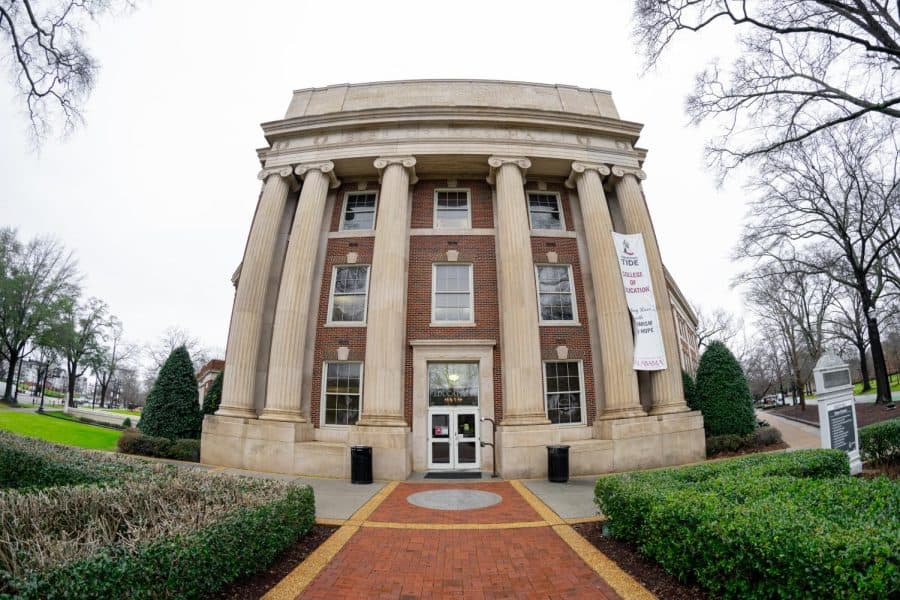Lucy-Graves Hall: UA building named for Autherine Lucy Foster on anniversary of enrollment
The University of Alabama will rename Graves Hall to Lucy-Graves Hall. Autherine Lucy Foster, the first African American student to enroll in the University, will share the building name with Bibb Graves, the former governor and a former officer of the Ku Klux Klan.
February 3, 2022
Graves Hall, which sits at the southwest corner of the Quad, has been renamed Lucy-Graves Hall.
The University of Alabama Board of Trustees voted to add Autherine Lucy Foster’s name to Graves Hall in honor of the 66th anniversary of her enrollment. Lucy was the first African American student to enroll at the University on Feb. 3, 1956.
The College of Education building was originally named after former Democrat, two-term Alabama governor and Ku Klux Klan member Bibb Graves.
The name change was prompted by the building names working group, which was responsible for the renaming of Wade Hall and The University of Alabama Student Center last semester. The English Building, Honors Hall and Presidents Hall are still awaiting new names after theirs were removed by the working group.
The group was formed on June 8, 2020, by the president pro tempore of the board of trustees. He appointed a working group of trustees to “conduct a comprehensive review of the names of buildings, structures, and spaces on all UA System campuses,” according to the board resolution.
Feb. 3, 1956
Lucy, who began her journey at the University on Feb. 3, 1956, completed three days of classes before riots and protests on campus led to her suspension. Trustee Emeritus Judge John England Jr. chair of the building names working group, told Lucy’s story before the board.
No other African American students attended the University until Vivian Malone and James Hood enrolled in 1963. Their acceptance followed then-Gov. George Wallace’s infamous Stand in the Schoolhouse Door.
Lucy opened the door that Wallace sought to symbolically close, England said.
The board considered Lucy for the building name after specific research was done into the history of Graves Hall itself. The resolution presented to the board described Lucy’s experience in Graves Hall, where she hid out from protesters outside the building, as “the site of one of the University of Alabama’s darkest moments.”
Lucy reenrolled in 1988 after earning a degree in English from Miles College and graduated in 1992 with her master’s degree. She is currently honored by the Autherine Lucy Clock Tower at Malone-Hood Plaza on campus, as well as through her endowed scholarship awarded each year to a Black undergraduate student by the Black Faculty and Staff Association.
Bibb Graves
“On the one hand, Gov. Graves is regarded by historians as one of, if not the most, progressive and effective governors in the history of the state of Alabama,” England said. “Some say he did more to directly benefit African American Alabamians than any other governor through his many reforms.”
These reforms included a doubling of education appropriations in his first term, the creation of the Division of Negro Education within Alabama’s Department of Education, the expansion of now Alabama State University from a two-year to a four-year institution and the breakup of a longstanding prison labor practice that modeled slavery.
While these were achievements for the state, board members were unable to look past Graves’ conflicting membership in the Klan.
“Unfortunately, that same Gov. Graves was associated with the Ku Klux Klan,” England said. “Not just associated with the Ku Klux Klan, but a Grand Cyclops. It’s hard for me to even say those words.”
A Grand Cyclops is a chief officer of a Ku Klux Klan chapter who appoints others to leadership positions. Graves held this role when he was initially elected as governor.
“We also considered the contributions made and we decided, after much wrestling with it, should this man’s initial and temporary political association with such an organization outweigh the tremendous progress and positive impact achieved? We’re talking about during a time when Alabama was rigidly segregated.”
Graves’ Klan involvement
The working group decided to leave Graves’ name among the two on the building, citing past political motivations as reason for involvement in the Klan. England compared Lucy’s overcoming of racism, segregation and violence, a “sign of the Klan’s defeat,” to Graves’ eventual “monumental steps” to resist the Klan, which he was involved with at the start of his career.
“Many historians have concluded that Gov. Graves’s association with the KKK was a political maneuver in that it helped Gov. Graves along with certain allies such as Hugo Black build a coalition — which included labor unions, prohibitionists, and women’s suffrage advocates — that ultimately helped him secure the 1926 gubernatorial election against the ‘Big Mules’ who dominated state politics in that era,” the board resolution said.
Graves renounced his Klan membership in 1928.
Many universities across Alabama bear Graves’ name somewhere on their campus. Some have removed it since the original installment. In 2020 Alabama State University, a historically Black college that Graves expanded during his governorship, removed his name from one of its residence halls.
Troy University erased Graves from one of its business college buildings, replacing his name with that of late activist and congressman John Lewis in 2020.
Graves’ name remains on buildings at Auburn University, the University of Montevallo and the University of North Alabama. The University has reaffirmed its commitment to honoring Graves even after extensive review.
In addition, the resolution hinted at future plans for The University of Alabama to “prepare a plaza between McClure Library and Lucy-Graves Hall to memorialize [Foster’s] leadership in overcoming” what they deemed “the blight of racial segregation.”








